ving作状语
- 格式:docx
- 大小:17.07 KB
- 文档页数:4
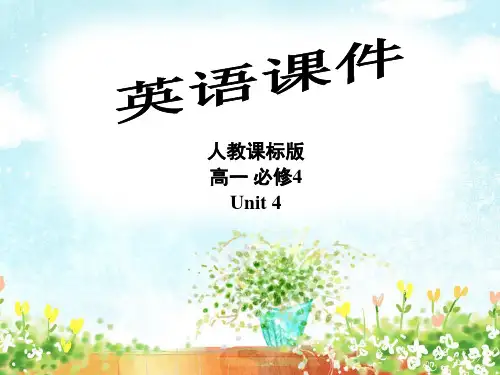
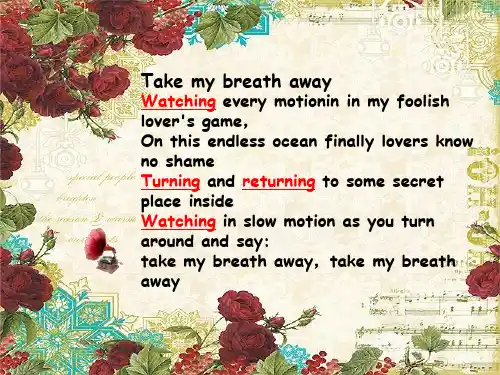


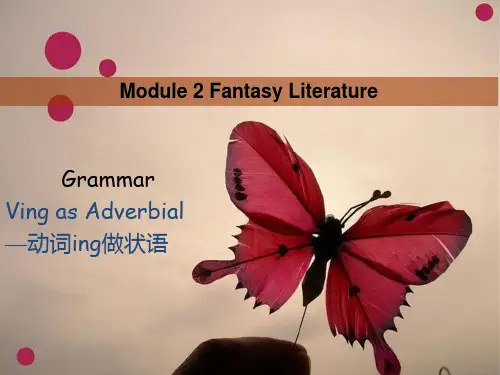
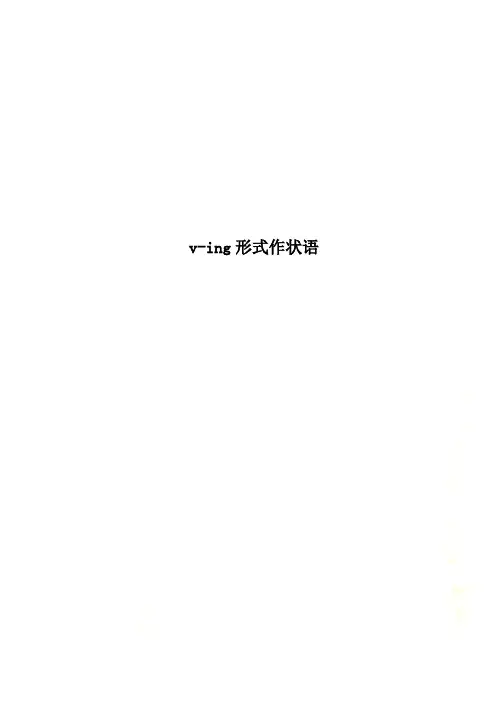
v-ing形式作状语v-ing形式作状语v-ing形式作状语时,用于修饰某动词或整个句子,所表示的动作与句子主语构成逻辑上的主谓关系。
v-ing形式作状语时,可以单独使用,也可以在其前加上when,while,after,if,unles s,although,though等连词,表示时间、原因、条件、让步、结果、伴随、方式等。
1. 作时间状语Hearing this news, she got frightened. 听到这个消息,她感到害怕。
Looking out of the window, I saw some children playing football.Turning around , he saw a tiger running up.2. 作结果状语The boy ran even faster,reaching the school out of breath. 那个男孩跑得更快了,到达学校时累得上气不接下气了。
The child slipped and fell, hitting his head against the door.Her husband died, leaving her four children.They fired, killing many people in the street.3. 作伴随状语He stood by the window, watching people passing by his window.He came running.She stood waiting for a bus.He sat there reading a book.The students ran out of the classroom, talking and laughing.4. 作原因状语Being a student, I must study hard. 作为一名学生,我必须努力学习。
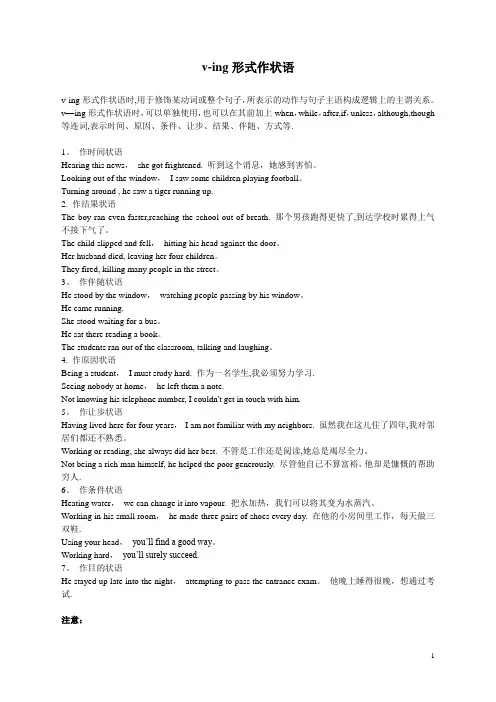
v-ing形式作状语v-ing形式作状语时,用于修饰某动词或整个句子,所表示的动作与句子主语构成逻辑上的主谓关系。
v—ing形式作状语时,可以单独使用,也可以在其前加上when,while,after,if,unless,although,though 等连词,表示时间、原因、条件、让步、结果、伴随、方式等.1。
作时间状语Hearing this news,she got frightened. 听到这个消息,她感到害怕。
Looking out of the window,I saw some children playing football。
Turning around , he saw a tiger running up.2. 作结果状语The boy ran even faster,reaching the school out of breath. 那个男孩跑得更快了,到达学校时累得上气不接下气了。
The child slipped and fell,hitting his head against the door。
Her husband died, leaving her four children。
They fired, killing many people in the street。
3。
作伴随状语He stood by the window,watching people passing by his window。
He came running.She stood waiting for a bus。
He sat there reading a book。
The students ran out of the classroom, talking and laughing。
4. 作原因状语Being a student,I must study hard. 作为一名学生,我必须努力学习.Seeing nobody at home,he left them a note.Not knowing his telephone number, I couldn't get in touch with him.5。
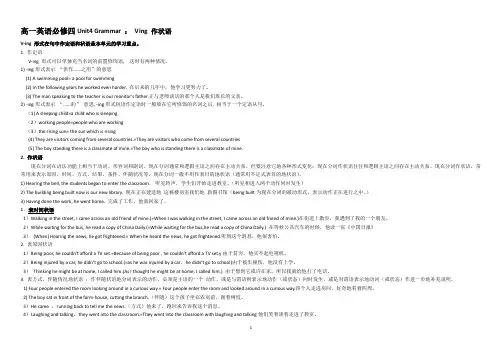
高一英语必修四Unit4 Grammar :Ving 作状语V-ing 形式在句中作定语和状语是本单元的学习重点。
1. 作定语V-ing 形式可以单独充当名词的前置修饰语, 这时有两种情况。
1) -ing形式表示“供作......之用”的意思(1) A swimming pool= a pool for swimming(2) In the following years he worked even harder. 在后来的几年中,他学习更努力了。
(3) The man speaking to the teacher is our monitor's father.正与老师谈话的那个人是我们班长的父亲。
2) -ing形式表示“......的”意思, -ing形式短语作定语时一般放在它所修饰的名词之后, 相当于一个定语从句。
(1) A sleeping child=a child who is sleeping(2)working people=people who are working(3)the rising sun= the sun which is rising(4) They are visitors coming from several countries.=They are visitors who come from several countries(5) The boy standing there is a classmate of mine.=The boy who is standing there is a classmate of mine.2. 作状语现在分词在语法功能上相当于动词、形容词和副词。
现在分词通常和逻辑主语之间存在主动关系。
但要注意它地各种形式变化:现在分词作状语往往和逻辑主语之间存在主动关系。
现在分词作状语,常常用来表示原因、时间、方式、结果、条件、伴随状况等。

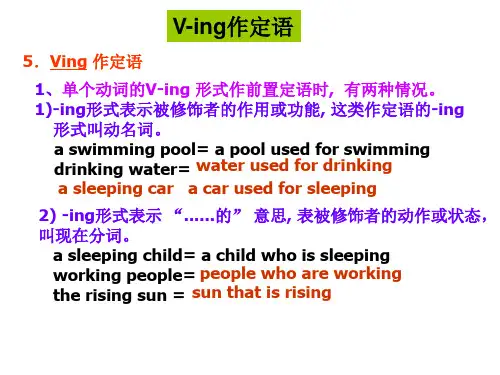
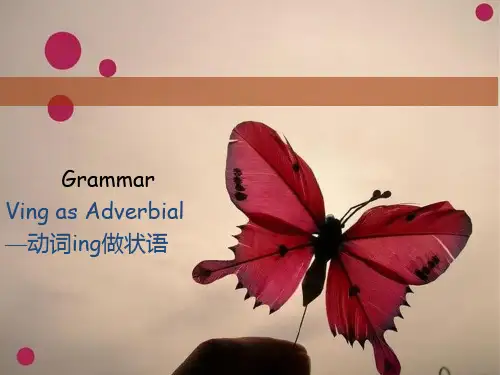
v-ing 形式作状语v-ing 形式作状语时,用于修饰某动词或整个句子,所表示的动作与句子主语构成逻辑上的主谓关系。
v-ing形式作状语时,可以单独使用,也可以在其前加上when, while , after, if, unless, although , though 等连词,表示时间、原因、条件、让步、结果、伴随、方式等。
1.作时间状语Hearing this news, she got frightened. 听到这个消息,她感到害怕。
Looking out of the window, I saw some children playing football.Turning around , he saw a tiger running up.2.作结果状语The boy ran even faster, reaching the school out of breath. 那个男孩跑得更快了,到达学校时累得上气不接下气了。
The child slipped and fell, hitting his head against the door.Her husband died, leaving her four children.They fired, killing many people in the street.3.作伴随状语He stood by the window, watching people passing by his window.He came running.She stood waiting for a bus.He sat there reading a book.The students ran out of the classroom, talking and laughing.4.作原因状语Being a student, I must study hard. 作为一名学生,我必须努力学习。
Seeing nobody at home, he left them a note.Not knowing his telephone number, I couldn't get in touch with him.5.作让步状语Having lived here for four years, I am not familiar with my neighbors. 虽然我在这儿住了四年,我对邻居们都还不熟悉。
Working or reading, she always did her best. 不管是工作还是阅读,她总是竭尽全力。
Not being a rich man himself, he helped the poor generously. 尽管他自己不算富裕, 他却是慷慨的帮助穷人。
6.作条件状语Heating water, we can change it into vapour. 把水加热,我们可以将其变为水蒸汽。
Working in his small room, he made three pairs of shoes every day. 在他的小房间里工作,每天做三双鞋。
Using your head, you 'll find a good way.Working hard, you 'll surely succeed.7. 作目的状语He stayed up late into the night, attempting to pass the entrance exam. 他晚上睡得很晚,想通过考试。
注意:、V-ing 的时态和语态。
F 表以动词:1.现在分词的一般式表示该动作在与谓语动作同时发生或在谓语动作之后发生,完成式则表示该动 作发生在谓语动作之前,在句中只能作状语表示时间和原因。
如:Standing on top of the hill, you can see as far as the seaside.(分词动作与谓语动作同时发生 ) The fish can eat a person in two minutes, leaving only bones.(分词动作在谓语动作之后发生 ) Havi ng fini shed his homework, the boy went out to play football.(分词动作在谓语动作之前发生)Having turned off the TV set, he baga n to do his homework.2.现在分词的主动式表示动作是由句子主语发出,而被动式表明主语承受该动作。
如: Being no ticed by so many people, she felt n ervous, not knowing what to say. Being helped by the teacher, she will lear n En glish well. Having bee n show n the lab, we were take n to see the library.Having bee n tran slated into many Ian guages, the book was widely read all over the world.Not havi ng heard from her son for a long time, the mother worried a great deal. Not havi ng bee n washed in the correct way, the coat has faded.二、现在分词可以与 when, while, if, though 等连词使用。
如:When doing your homework, you must n't liste n to the music.Though hav ing bee n warned many times, she got to school late aga in. While read ing the book, she no dded from time to time.三、v-ing 形式作状语时,它的逻辑主语必须与主句的主语是一致的。
Rushi ng into the dinin g-room, supper was wait ing for me. ( X ) Rushi ng into the dinin g-room, I found supper was wait ing for me. While visit ing a stra nge city, a guide-book is very help ful.( X ) While visit ing a stra nge city, you may find a guide-book very help ful. 四、当现在分词的逻辑主语不是句中主语时,可以带有自己的主语 属于独立主格结构,有时前面还可加介词 with 构成复合结构。
3. 现在分词的否定式是在一般式和完成式的前面加加在have 前。
如:not (never )。
注意完成式的否定式应将 not (never )--名词或代词主格。
这样的结构ving 作状语Spring coming on, the trees turned green. Her mother being ill, she had to look after her at home.Time permitting, we ' ll visit the Great Wall. He guiding the blind man, they walked slowly across the street. Weather permitting, we will go out for a picnic next Sunday. With so many people looking at her, the girl felt nervous. 五 . 固定结构: v-ing 形式可以作独立成分,表示说话人的态度或看问题的角度。
如: Judging from his appearance, he must be a very healthy boy. Generally speaking, boys are more active than girls in sports. Judging from his appearance, he must be very rich. Generally speaking, his answer is right. Considering everything, they did a good job. 六、 V-ing 形式作状语时,可以用相应的状语从句替代,从句谓语必须用主动语态。
Seeing the picture, I couldn 'heIp thinking of the days in Amenca.(=When I saw the picture, I …) While reading the book, she nodded from time to time. ( = While she was reading the book, she nodded from time to time. ) Being a student, I must study hard. (= As I am a student, I must study hard.) Not knowing how to do it, he asked the teacher for help. (= As he didn teacher for help.)由于不知道如何干,他请老师帮助。
't know how to do it, he aske Meeting anywhere else, we wouldn ' htave recognized each other. (=If we had met anywhere else, we wouldn ‘ t have recognized each othe 如果是在别处见面,我们彼此会认不出来的。
边学边练 : 1. Don ' t sit there nothing at all. Come and help me with this table. A. do B. to do C. doing D. and doing 2. The snow storm left, ______ a lot of damage to southern China. A. caused B. to have caused C. to cause D. having caused 3. He glanced over at her, ______ that though she was tiny, she seemed very well put together. A. noting B. noted C. to note D. having noted 4. _______ in a white uniform , he looks more like a cook than a doctor. A. Dressed B. To dress C. Dressing 5. The manager, A. who has made C. made 翻译下列句子。